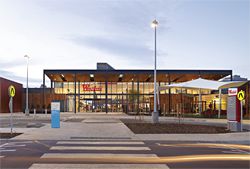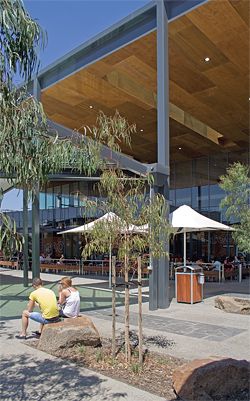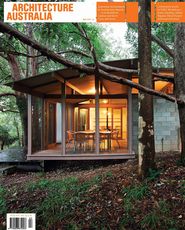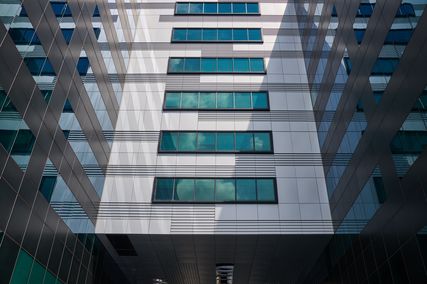
Westfield, Plenty Valley, by NHArchitecture. Photograph Derek Swalwell.

Detail of Westfield at Plenty Valley. Photograph Catherine Endersby of NHArchitecture.
What roles might architects play in the making of communities? Hamish Lyon considers the contemporary situation and speculates on how we might re-engage with the everyday communual environment.
Does the public care about architecture anymore? I mean really care.
Or has their interest been numbed by years of glossy lifestyle programs telling them that design can be bought from a shopping centre and that DIY can replace professional advice? In this forum architects are regularly portrayed either as design stylists called on to adjudicate on current trends or as erstwhile green activists, offering handy advice on how to reduce energy and water consumption. The most elaborate caricature is reserved for the architect dressed entirely in black and expressing an antiseptic vision for a stainless steel world, with a self-righteous moralism that belongs in the Victorian era. Sadly, some of these stereotypes are a bit too close to reality, with the result that the voice of the architect in the community has been marginalized. When architects seek broad community support for a relevant cause or social issue, the response from the public is often timid at best and disinterested at worst.
This was clearly revealed in the deeply divided battle over Federation Square, where the infamous shards were deemed to be inappropriate in the historical context of sightlines to St Paul’s Cathedral. The subsequent loss of one shard during the construction phase of the project became a rallying point for many in the design profession against direct political interference in the making of significant cultural places. The public, however, could only enter the conversation through the highly polarized and mostly negative opinions in the popular press. It suggested that the voice of the architect (in the first person) was less significant than the community perception of the architects and their role in the making of public architecture. The corollary to the story was an immediate acceptance of the project by the public on its completion, when the realities of the work could be directly engaged without the mediating process of either the tabloid press or backroom politics. Federation Square is now the centrepiece of Melbourne’s cultural life and firmly entrenched in the collective consciousness of its citizens.
Beyond these high-profile battles, architecture continues to be deeply embedded within the community. This is evident on the nightly news. Victorians recently commemorated the first anniversary of the Black Saturday bushfires in a number of local and community ceremonies. The first news report showed how many of these gatherings used the local sports ground and associated facilities as the venue for the occasion, while in other cases the fire-affected towns need to rebuild their community infrastructure. In the total absence of local public facilities such as schools, kindergartens, medical centres and sports halls, the community has awoken an unusually strong cooperation between all levels of government and their associated agencies, with community representatives providing direct and valuable input into the rebuilding process. This relationship between the community and the physical fabric of place making will result in a genuine sense of architectural participation.
The news item that followed the bushfire coverage, however, showed an angry group of residents venting their disbelief that a large shopping centre, which had been part of the community for several generations, was proposing a ten-storey residential development as part of the centre’s continuing upgrade. Behind the sensational claims, neatly edited into prime-time sound bites, it was revealed that the project is founded on endorsed public policy and in accordance with the local and state planning frameworks. While the resident action group believed the proposal to be illegal and offensive, and their outrage to be a true reflection of a community view, this ran contrary to the fact the project was grounded in an established democratic process. The development of the residential towers was presented as unacceptable, and in contrast to the more morally virtuous idea of rebuilding a town devastated by bushfire. In both cases the limits of community expectations were being tested through architecture as the physical embodiment of a collective agenda. But what governs community views and judgment? Why should we care about one issue and not another? And what is the definition of community opinion?
Architects have been invited to express their views on this as part of the Now + When exhibition at this year’s Australian Pavilion for the Venice Biennale. The curators’ ambitious proposition asks us to speculate on the nature of Australia’s urban landscape in 2050 and the role architecture may play. Ironically, this comes at a time when contemporary architecture is being buffeted by the global financial crisis at both a professional and ideological level, and the debate on the nature of communities has begun to develop sharp political teeth. For example, Sydneysiders are currently facing an urban crisis generated by a public transport system failing on a catastrophic scale. The outer metropolitan ring of Sydney’s sprawl is becoming highly unstable: a place where communities are not defined by the traditional attributes of neighbourhood but by the logistics of Sydney’s road network or the distance to the nearest bus stop. In Melbourne the suburban sprawl continues to expand despite the protestation of urban planners. The balance between the cost of infrastructure and an economy essential to the health of both local and state government revenue has ensured continuing growth on the outer edge. The unstoppable “house and land” sales have seen the supposedly fixed line of the urban growth boundary remain as elastic as politically acceptable. Equally, cities such as Perth continue to creep gradually along the coastline under the promise that each new estate will be connected to an extension of the public transport corridors and upgraded road network. Australia’s urban centres are beginning to reach the critical limits of this model before communities become socially and physically dysfunctional.
Historically, these issues were the domain of the three-tier system of local, state and federal government. A typical postwar suburb was served by town halls, post offices, schools, hospitals and sport facilities, while the bowls club and Scout halls were the friendly face of local gatherings. In the current political climate of privatized public infrastructure, the relationship between the community and its civic institutions has become blurred. The certainties of a centralized government have been replaced by a network of outsourced contracts and a trail of responsibility, which eventually leads to a recorded phone message requesting that you select the appropriate number from the menu. In fact, the word “community” has been bleached of its meaning by overuse in planning reports, in policy agenda and by large volume home builders, who use the catchphrase of “building communities” to camouflage their economic need to continually subdivide new land. This subterfuge is captured in commercials that reinforce the perception that these new housing estates provide more than the isolated experience of the single domestic dwelling. They promise a lifestyle free of stress and a neighbourhood full of young couples walking through meadows while children ride their bikes by an artificial lake. Mum has a latte with the girls and Dad is off playing endless golf. At the centre of these estates are lifestyle centres built as part of the commercial offering and promoted as the centre of community life. Alternatively, there is the local “activity centre” comprising a supermarket, specialty shops, a medical centre and commercial offices. By default, these projects have become the new community infrastructure and have replaced traditional nineteenth-century institutions. Yet they do not receive adequate architectural attention and are driven by harsh commercial forces. There are a number of examples, across the suburban landscape of Australia’s major cities, in which communities in need of a genuine civic focus find themselves adjacent to a major arterial freeway, complete with monumental noise-walls and commissioned public art designed by a leading architect or artist. Such designers have invariably been selected through an exhaustive consultation process or an invited design competition. It seems ironic that the design profession’s commitment to the anonymous car dwellers flying past one community after another is infinitely greater than to the people who actually have to live there. Has the freeway experience finally superseded the ideals of the home, the street and the community?
Over the last twenty years the design profession has followed a shining path of ever more gleaming and luxurious projects across the complete geopolitical spectrum, but now the role of community architecture is returning to the centre of debate. Prophetically, it took the near collapse of international capitalism and a renewed requirement for central governments to re-establish themselves as owners of public institutions and funders of public policy to re-engender a social dimension to architecture and urbanism. The task ahead is for the profession to rejoin this debate and begin again to value the suburban landscapes of our cities.
Hamish Lyon is a principal of NHArchitecture.















